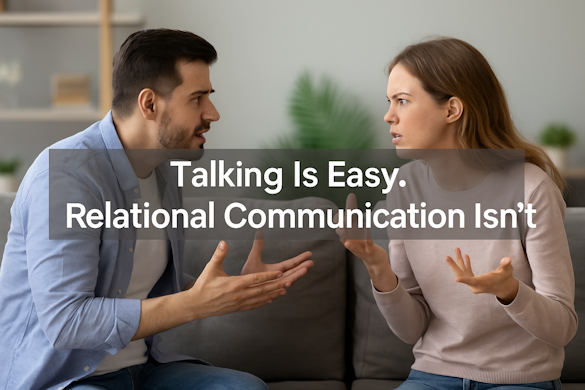It’s Not About Making It Seamless. It’s About Making It Honest.

f you’re in a relationship where one partner brings children into the home and the other doesn’t, you already know—this isn’t just about love.
It’s about navigating the constant tension between belonging and being an outsider.
It’s about trying to be part of a family that already exists—without losing yourself in the process.
Most couples in this situation hope that, with time, things will “blend.”
But here’s the truth:
Blending isn’t the goal. Navigating the reality is.
Let’s talk about why this setup is so tough—and what it actually takes to build something real.
Why These Stepfamily Dynamics Are So Complex
This isn’t about two families merging.
It’s about
one family system already in place—and a new adult trying to find their footing inside it.
Here’s what makes it so layered:
- The biological parent is deeply bonded with their children
- The new partner may love the parent—but feels left out, invisible, or like a guest in their own home
- The children may see the new adult as a threat, an intrusion, or someone who “doesn’t belong”
- Ex-partners, parenting norms, or custody schedules add additional layers of pressure and unpredictability
And it all unfolds inside your home—every single day.
It’s not just about logistics.
It’s about identity, belonging, and navigating emotional terrain that’s rarely acknowledged, let alone taught.
What the “Outsider” Often Feels (But Rarely Says)
I’ve worked with many partners who stepped into these dynamics with hope and love—only to end up feeling:
“I feel like I’m always walking on eggshells.”
“I have no say, but I’m expected to help.”
“They say I’m part of the family, but I don’t feel like it.”
“I don’t know my place—and when I try to speak up, I’m the bad guy.”
Meanwhile, the parent may be thinking:
“I feel torn between defending my partner and protecting my kids.”
“It’s easier to avoid conflict than name what’s not working.”
“I’m exhausted and just want peace in the house.”
This creates a cycle where both adults feel unseen, unappreciated, and unsure how to move forward.
What RLT Teaches About This Dynamic
Relational Life Therapy doesn’t sugarcoat this.
We don’t aim for instant family. We aim for
clear roles, honest conversations, and mature leadership.
What matters most is:
- Clarity about the outsider experience
- Accountability around how decisions are made
- Boundaries that protect the couple and the children
- Repair tools when emotional wounds happen (and they will)
- Respect for the pacing of trust—especially with kids
Five Real Tools for Navigating This Stepfamily Structure
If this is your life, here’s where to begin:
1. Name the Outsider Dynamic Without Shame
Call it what it is.
You can’t fix what you won’t name.
“I sometimes feel like a visitor in our home. Can we talk about how to shift that together?”
Said with care, this isn’t a complaint. It’s a doorway to deeper honesty.
2. Set Clear Couple Agreements—Privately
The couple relationship must come first—not emotionally over the kids, but as the decision-making unit.
Have regular, private check-ins where you:
- De-brief family dynamics
- Set unified boundaries
- Discuss parenting decisions before they’re presented to the kids
The message is: We’re in this together—even if our roles are different.
3. Respect That You’re Not the Parent (Yet)
You may be helping with day-to-day life, but that doesn’t give you automatic authority.
Trust with the children must be earned, not assumed.
Your early job is to be an ally—not a disciplinarian.
Influence grows through connection, not correction.
If you feel you’re being expected to parent without power—that’s a conversation to have with your partner, not with the child.
4. Hold Space for the Parent-Child Bond
It can be painful to watch your partner be close with their children while you feel peripheral.
But part of maturity in this role is learning not to take that closeness personally.
Instead of fighting for inclusion, try this:
“I can see how much you love your kids. I support that. And when you have space, I’d love more intentional time for us, too.”
This honors the bond while gently advocating for your own connection.
5. Stop Measuring “Success” By How Much You Blend
There’s no scorecard for how close you are to your partner’s kids.
Some relationships will become loving and intimate. Others will remain respectful and distant.
Either way, what matters is that:
- No one feels forced
- Everyone feels respected
- You and your partner stay on the same team
That’s what success looks like in these dynamics.
Final Thought: You’re Not Doing It Wrong. You’re Doing Something Hard.
If you’ve stepped into a family structure that was already in motion—
You’re not broken.
You’re not failing.
You’re doing something extraordinary.
You’re building a relationship in the middle of a system that wasn’t built with you in mind.
Love isn’t always enough. But with honesty, boundaries, and relational skill—you can create something strong, even if it doesn’t look traditional.
Blending isn’t the goal.
Belonging—with clarity and grace—is.
Relationship Solutions Blog










